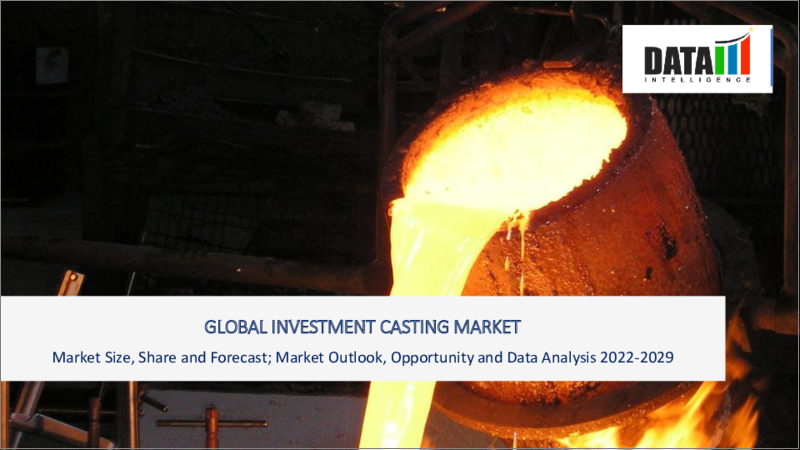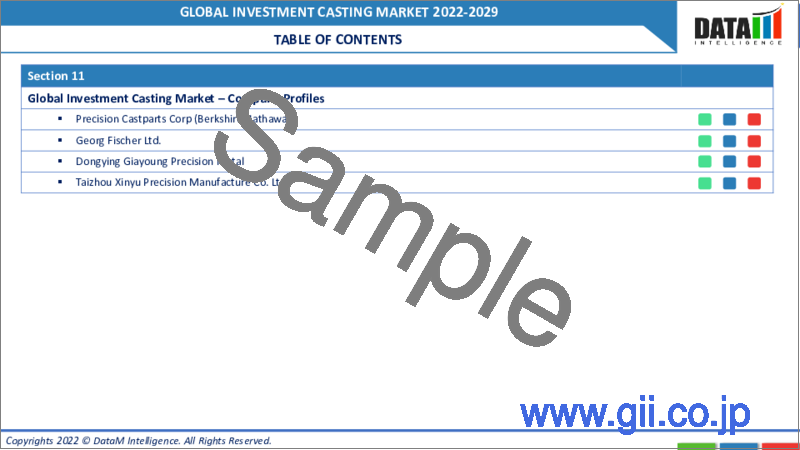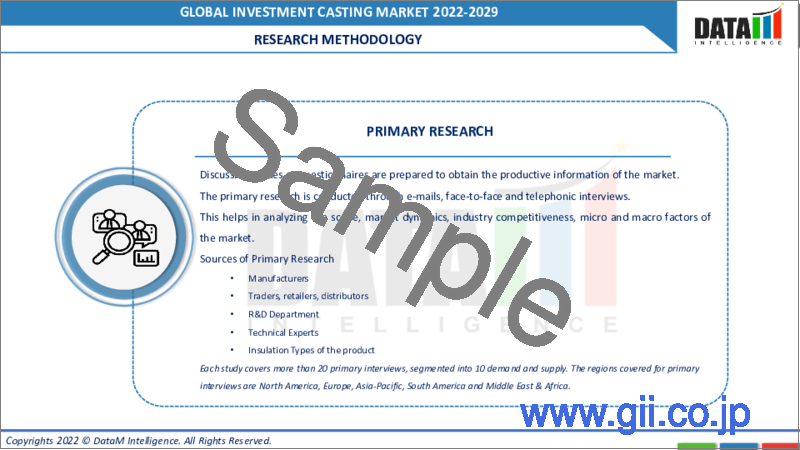|
|
市場調査レポート
商品コード
1107818
インベストメント鋳造の世界市場(2022年~2029年)Global Investment Casting Market - 2022-2029 |
||||||
|
● お客様のご希望に応じて、既存データの加工や未掲載情報(例:国別セグメント)の追加などの対応が可能です。 詳細はお問い合わせください。 |
|||||||
| インベストメント鋳造の世界市場(2022年~2029年) |
|
出版日: 2022年07月31日
発行: DataM Intelligence
ページ情報: 英文 208 Pages
納期: 約2営業日
|
- 全表示
- 概要
- 目次
世界のインベストメント鋳造の市場規模は、高度な部品を開発するために自動車や輸送分野での使用が増加していることなどによって促進されています。
当レポートでは、世界のインベストメント鋳造市場を調査しており、市場の概要、市場規模や予測、動向、成長要因および課題、顧客情勢、タイプ・エンドユーザー・地域別の分析、さら企業プロファイルなどを提供しています。
目次
第1章 世界のインベストメント鋳造市場の調査手法と範囲
- 調査手法
- 調査の目的と調査範囲
第2章 世界のインベストメント鋳造市場-市場の定義と概要
第3章 世界のインベストメント鋳造市場-エグゼクティブサマリー
- タイプ別の市場内訳
- エンドユーザー別の市場内訳
- 地域別の市場内訳
第4章 世界のインベストメント鋳造市場-市場力学
- 市場に影響を与える要因
- 促進要因
- 抑制要因
- 機会
- 影響分析
第5章 世界のインベストメント鋳造市場-業界分析
- ポーターのファイブフォース分析
- サプライチェーン分析
- 価格分析
- 規制分析
第6章 世界のインベストメント鋳造市場COVID-19分析
- 市場におけるCOVID-19の分析
- COVID-19以前の市場シナリオ
- 現在のCOVID-19市場シナリオ
- COVID-19後または将来のシナリオ
- COVID-19の中での価格変動
- 需給スペクトル
- パンデミック時の市場に関連する政府の取り組み
- メーカーの戦略的イニシアチブ
- 結論
第7章 世界のインベストメント鋳造市場-タイプ別
- イントロダクション
- タイプ別の市場規模分析と前年比成長分析
- タイプ別の市場魅力指数
- ケイ酸ナトリウム法*
- イントロダクション
- 市場規模分析と前年比成長分析
- オルトケイ酸テトラエチル/シリカゾル法
第8章 世界のインベストメント鋳造市場-エンドユーザー別
- イントロダクション
- エンドユーザー別の市場規模分析と前年比成長分析
- エンドユーザー別の市場魅力指数
- 自動車
- イントロダクション
- 市場規模分析と前年比成長分析
- 航空宇宙および軍事
- 一般産業機械
- 医療
- その他
第9章 世界のインベストメント鋳造市場-地域別
- イントロダクション
- 地域別の市場規模分析と前年比成長分析
- 地域別の市場魅力指数
- 北米
- イントロダクション
- 主要な地域固有のダイナミクス
- タイプ別の市場規模分析と前年比成長分析
- エンドユーザー別の市場規模分析と前年比成長分析
- 国別の市場規模分析と前年比成長分析
- 欧州
- イントロダクション
- 主要な地域固有のダイナミクス
- タイプ別の市場規模分析と前年比成長分析
- エンドユーザー別の市場規模分析と前年比成長分析
- 国別の市場規模分析と前年比成長分析
- 南米
- イントロダクション
- 主要な地域固有のダイナミクス
- タイプ別の市場規模分析と前年比成長分析
- エンドユーザー別の市場規模分析と前年比成長分析
- 国別の市場規模分析と前年比成長分析
- アジア太平洋
- イントロダクション
- 主要な地域固有のダイナミクス
- タイプ別の市場規模分析と前年比成長分析
- エンドユーザー別の市場規模分析と前年比成長分析
- 国別の市場規模分析と前年比成長分析
- 中東とアフリカ
- イントロダクション
- 主要な地域固有のダイナミクス
- タイプ別の市場規模分析と前年比成長分析
- エンドユーザー別の市場規模分析と前年比成長分析
第10章 世界のインベストメント鋳造市場-競合情勢
- 競合シナリオ
- 市場ポジショニング/シェア分析
- 合併と買収の分析
第11章 世界のインベストメント鋳造市場-企業プロファイル
- Signicast
- 企業概要
- 製品ポートフォリオ・種類
- 主要ハイライト
- 財務概要
- MetalTek International
- Milwaukee Precision Casting, Inc.
- Impro Precision Industries Limited
- Alcoa Corporation
- Zollern GmbH and Co. K.G.
- Precision Castparts Corp(Berkshire Hathaway)
- Georg Fischer Ltd.
- Dongying Giayoung Precision Metal
- Taizhou Xinyu Precision Manufacture Co. Ltd
第12章 世界のインベストメント鋳造市場-重要考察
第13章 世界のインベストメント鋳造市場-DataM
- 付録
- 弊社とサービスについて
- お問い合わせ
Market Overview
The global investment casting market was worth US$ XX million in 2021 and is estimated to reach US$ XX million by 2029, growing at a CAGR of XX % during the forecast period (2022-2029).
Even though investment casting has been utilized since the ancient Egyptians did so between 4,000 and 3,000 B.C., it wasn't until after World War II that its industrial significance and popularity increased because of the growth of the market for parts in the aircraft engine and airframe sectors. From the early days when clay was packed around the bee's wax pattern to ceramic shells and the introduction of special dewaxing ovens, lost wax casting has evolved.
Investment casting, also known as lost-wax casting, is an industrial manufacturing process that involves immersing wax patterns or structures in a refractory material slurry to form a ceramic, plaster, or plastic shell. The wax pattern is melted in a furnace to make a casting and metal is poured into the body. The process is widely used in producing machinery components, automotive components, turbine blades, dental fixtures, etc. It reduces energy, material and subsequent machining waste and it aids in creating intricate designs with accurate and smooth finishing.
The process has successfully cast parts up to 1.5 m in diameter and 1140 kg in weight in the past, though the specific component is less than 100 mm in size and weighs less than 500g. As a result, this process has a wide range of applications in the automotive, aerospace, military, medical and oil & gas industries. The increasing use of investment casting in the automotive and transportation sectors to develop advanced components such as engine parts, compressor components and gearbox components are expected to drive the market in the long term.
The high manufacturing cost of dies traditionally limited investment casting to large production quantities. Still, the introduction of additive manufacturing or 3D printing of wax patterns in recent years has eliminated the manufacturing cost of dies and allowed for shorter runs.
Market Dynamics
The growing aerospace and military industries are driving investment casting demand, as many different applications and parts of aircraft, helicopters and jets are produced through investment casting. The safety of the airplane depends on its hydraulic fluid system, landing and braking systems and flight critical and safety components.
Manufacturing costs, high energy consumption and other factors limit demand for the investment casting market. However, foundries are attempting to overcome these challenges by collaborating to develop advanced casting technologies based on simulations, which are expected to reduce shop-floor time and increase casting yield.
The rising demand for investment casting in various end-use industries
Because of its ability to make fine impressions and specified pieces with maximum precision, investment casting has become an important component of the industrial sector. Dairy, mining, pharmaceuticals and power industries require accurate stainless steel casting. Utilities like these have accelerated the growth of the investment cast sector. It also produces car components such as the fuel system, brakes, chassis and other body components. Thailand's expansion in the investment casting business can be seen as a parallel to the increase in vehicle production in various Asian countries like India.
In recent years, significant growth in the aviation and aerospace industries is one of the key factors driving the market forward. As a result, investment casting processes are widely used to produce military aircraft, jets, launch vehicles, helicopters and commercial transport vehicles. Furthermore, rising environmental consciousness and a greater emphasis on sustainable development propel market growth. The wax used in investment casting is usually melted and reused to make various shapes and sizes of components.
Technological advancements in investment casting methods
Other growth-inducing factors include improvements in casting processes through simulations and the utilization of metal additive manufacturing practices, all-in-one 3D printing, X-ray defect detection and casting and forging techniques. These processes aid in the production of products that are cost-effective, stable and structurally durable.
High initial costs and regulatory implications
High manufacturing costs and high energy consumption slow the market's growth. Because of the significant cost required, the investment cast method is not ideal for more extensive features such as airplane doors and panels. Sand casting, for example, is better suited for large-scale components. However, foundries are attempting to overcome these challenges by collaborating to develop advanced casting technologies based on simulations, which are expected to reduce shop-floor time and increase casting yield.
Regulatory consequences for the investment casting business have little impact on growth. The regulatory organizations are only concerned with the disposal of waste items. Dumping them into bodies of water is not a very healthy option because it poses a serious hazard to the flora and animals within the water. Furthermore, it has an impact on the ecological equilibrium. Various laws have been enacted to put a stop to such practices.
COVID-19 Impact Analysis
The COVID-19 outbreak had an immediate and severe impact on many industries worldwide. The pandemic put tremendous strain on sectors, resulting in a drop in global demand. With declining demand in mind, the companies rethink their post-pandemic strategies and operational plans. Because economies are slowly recovering, the investment casting market is expected to grow positively during the forecast period.
Segment Analysis
By type, the investment casting market is classified into sodium silicate and tetraethyl orthosilicate/ silica sol processes.
The sodium silicate process gradually gains popularity
Silica sol casting improves dimensional accuracy and surface finish while minimizing defects in investment castings. As a result, the process is more expensive than water glass casting. Silica sol zircon sand is costly and the preparation required is also more expensive, which is a significant reason for the higher prices. Because of its higher costs, the silica sol process is used in fewer foundries. The silica sol investment casting in automotive or industrial components costs around 6.5 US$/kg. However, this process may be preferred if the end-user is primarily concerned with casting quality and a low repair rate.
Compared to the water glass process, the silica sol process can create extra-large parts weighing 50-100kgs. The method is therefore utilized to create larger, heavier parts, including valve plates, impellers, diversion shells, pump bodies and ball valve bodies. Simultaneously, the process is widely used to produce extra small (2-1000g) parts that require high dimensional accuracy, such as those used in Asia-Pacific. Due to the ongoing efforts to improve the quality and dimensional accuracy of the components produced, the Sodium Silicate Process is gradually gaining popularity.
Geographical Analysis
Expansion of various manufacturing industries in North America
North America currently leads the investment casting market and is expected to do so in the future. The growth of North America is attributed to several factors, including the development of the manufacturing industries, particularly industrial gas, aerospace and defense applications and important defense aircraft and component producers in the area, like Lockheed Martin, Raytheon and Northrop Grumman. With important aircraft programs like the Boeing 737, Boeing 777, Boeing 787 and Airbus A220 production facilities, aerospace manufacturing is a sizable business in the United States. The requirement for investment casting parts is anticipated to rise as the nation's manufacturing of military aircraft programs like the F-35 increases.
According to the American Automotive Policy Council, the automotive industry is the largest manufacturing sector in U.S., with vehicles and parts worth US$ 692 billion in the last five years. In 2020, approximately 8.8 million motor vehicles will be manufactured in U.S. In 2020, U.S. exported about 1.4 million passenger and light vehicles. According to the Aerospace Industries Association of Canada, the aerospace industry generated US$ 14.2 billion in revenue in 2018. The sector's value fell from US$ 24 billion in 2019 to US$ 24 billion in 2020. Some of the country's major aerospace manufacturers include Airbus, Boeing, De Havilland Canada and Bombardier Inc. Currently, aerospace company production has slowed, with 95 percent operating at partial capacity. De Havilland Canada intends to begin aircraft production in stages.
Competitive Landscape
The investment casting market is competitive with numerous international and regional investment casting manufacturers. Because the market is fragmented, businesses are making investments, partnerships, joint ventures, acquisitions and staying ahead of the competition. Signicast, for example, signed an agreement in February 2019 to acquire CIREX, a European investment casting specialist based in Netherlands, from Amsterdam-based investment firms Convent and Nedvest. The acquisition will allow Signicast to serve its growing international customer base better. The combined operation will now have plants in the Netherlands, Czech Republic, Slovakia and Signicast's three facilities in U.S.
Key players operating in the global market for investment casting include Signicast, MetalTek International, Milwaukee Precision Casting, Inc., Impro Precision Industries Limited, Alcoa Corporation, Zollern GmbH and Co. K.G., Precision Castparts Corp (Berkshire Hathaway), Georg Fischer Ltd., Dongying Giayoung Precision Metal and Taizhou Xinyu Precision Manufacture Co. Ltd.
Emirates Central Cooling Systems Corporation (Empower)
Overview: With world-leading experts, rapid prototyping & delivery and the most advanced investment casting facilities globally, Signicast, a Form Technologies Company, redefines today's manufacturer's creation, refining and delivery of products. Signicast is a highly-automated, world-class supplier of precision investment castings located in North America and Europe.
Product Portfolio: The company provides an investment casting process, prototyping and investment casting metals from 400 series stainless steel to aluminum.
Key Development: An agreement has been inked by Signicast, a Form Technologies subsidiary, to buy Hutchins, Texas-based investment casting firm Consolidated Casting Corporation. The very first Signicast location outside of Wisconsin will be at Consolidated Casting. Consolidated Casting's acquisition broadens its reach in U.S., increases its services to the oil and gas industry and adds capacity for existing and emerging markets.
Additionally, the acquisition provides access to the complete Form Technologies platform of precision producers, including Signicast, Dynacast and OptiMIM, for current Consolidated Casting clients. During the design and manufacturing stages, the transition will guarantee that every consumer receives the stability of the Form business as well as knowledgeable insight and expertise.
Why Purchase the Report?
- Visualize the composition of the investment casting segmentation by type, end-user and region, highlighting the critical commercial assets and players.
- Identify commercial opportunities in investment casting by analyzing trends and co-development deals.
- Excel data sheet with thousands of data points of investment casting - level 4/5 segmentation.
- PDF report with the most relevant analysis cogently put together after exhaustive qualitative interviews and in-depth market study.
- Product mapping in excel for the key product of all major market players
The global investment casting report would provide access to an approx. 52 market data tables, 43 figures and 208 pages.
Target Audience
- Investment Casting Providers/ Buyers
- Industry Investors/Investment Bankers
- Education & Research Institutes
- Research Professionals
- Emerging Companies
- Manufacturers
Table of Contents
1. Global Investment Casting Market Methodology and Scope
- 1.1. Research Methodology
- 1.2. Research Objective and Scope of the Report
2. Global Investment Casting Market - Market Definition and Overview
3. Global Investment Casting Market - Executive Summary
- 3.1. Market Snippet By Type
- 3.2. Market snippet By End-User
- 3.3. Market Snippet by Region
4. Global Investment Casting Market-Market Dynamics
- 4.1. Market Impacting Factors
- 4.1.1. Drivers
- 4.1.1.1. The rising demand for investment casting in various end-use industries
- 4.1.1.2. Technological advancements in investment casting methods
- 4.1.2. Restraints
- 4.1.2.1. High initial costs and regulatory implications
- 4.1.2.2. XX
- 4.1.3. Opportunity
- 4.1.3.1. XX
- 4.1.4. Impact Analysis
- 4.1.1. Drivers
5. Global Investment Casting Market - Industry Analysis
- 5.1. Porter's Five Forces Analysis
- 5.2. Supply Chain Analysis
- 5.3. Pricing Analysis
- 5.4. Regulatory Analysis
6. Global Investment Casting Market - COVID-19 Analysis
- 6.1. Analysis of COVID-19 on the Market
- 6.1.1. Before COVID-19 Market Scenario
- 6.1.2. Present COVID-19 Market Scenario
- 6.1.3. After COVID-19 or Future Scenario
- 6.2. Pricing Dynamics Amid COVID-19
- 6.3. Demand-Supply Spectrum
- 6.4. Government Initiatives Related to the Market During Pandemic
- 6.5. Manufacturers Strategic Initiatives
- 6.6. Conclusion
7. Global Investment Casting Market - By Type
- 7.1. Introduction
- 7.1.1. Market Size Analysis and Y-o-Y Growth Analysis (%), By Type
- 7.1.2. Market Attractiveness Index, By Type
- 7.2. Sodium Silicate Process*
- 7.2.1. Introduction
- 7.2.2. Market Size Analysis and Y-o-Y Growth Analysis (%)
- 7.3. Tetraethyl Orthosilicate/ Silica Sol Process
8. Global Investment Casting Market - By End-User
- 8.1. Introduction
- 8.1.1. Market Size Analysis and Y-o-Y Growth Analysis (%), By End-User
- 8.1.2. Market Attractiveness Index, By End-User
- 8.2. Automotive
- 8.2.1. Introduction
- 8.2.2. Market Size Analysis and Y-o-Y Growth Analysis (%)
- 8.3. Aerospace & Military
- 8.4. General Industrial Machinery
- 8.5. Medical
- 8.6. Others
9. Global Investment Casting Market - By Region
- 9.1. Introduction
- 9.2. Market Size Analysis and Y-o-Y Growth Analysis (%), By Region
- 9.3. Market Attractiveness Index, By Region
- 9.4. North America
- 9.4.1. Introduction
- 9.4.2. Key Region-Specific Dynamics
- 9.4.3. Market Size Analysis and Y-o-Y Growth Analysis (%), By Type
- 9.4.4. Market Size Analysis and Y-o-Y Growth Analysis (%), By End-User
- 9.4.5. Market Size Analysis and Y-o-Y Growth Analysis (%), By Country
- 9.4.5.1. U.S.
- 9.4.5.2. Canada
- 9.4.5.3. Mexico
- 9.5. Europe
- 9.5.1. Introduction
- 9.5.2. Key Region-Specific Dynamics
- 9.5.3. Market Size Analysis and Y-o-Y Growth Analysis (%), By Type
- 9.5.4. Market Size Analysis and Y-o-Y Growth Analysis (%), By End-User
- 9.5.5. Market Size Analysis and Y-o-Y Growth Analysis (%), By Country
- 9.5.5.1. Germany
- 9.5.5.2. UK
- 9.5.5.3. France
- 9.5.5.4. Italy
- 9.5.5.5. Spain
- 9.5.5.6. Rest of Europe
- 9.6. South America
- 9.6.1. Introduction
- 9.6.2. Key Region-Specific Dynamics
- 9.6.3. Market Size Analysis and Y-o-Y Growth Analysis (%), By Type
- 9.6.4. Market Size Analysis and Y-o-Y Growth Analysis (%), By End-User
- 9.6.5. Market Size Analysis and Y-o-Y Growth Analysis (%), By Country
- 9.6.5.1. Brazil
- 9.6.5.2. Argentina
- 9.6.5.3. Rest of South America
- 9.7. Asia-Pacific
- 9.7.1. Introduction
- 9.7.2. Key Region-Specific Dynamics
- 9.7.3. Market Size Analysis and Y-o-Y Growth Analysis (%), By Type
- 9.7.4. Market Size Analysis and Y-o-Y Growth Analysis (%), By End-User
- 9.7.5. Market Size Analysis and Y-o-Y Growth Analysis (%), By Country
- 9.7.5.1. China
- 9.7.5.2. India
- 9.7.5.3. Japan
- 9.7.5.4. Australia
- 9.7.5.5. Rest of Asia-Pacific
- 9.8. The Middle East and Africa
- 9.8.1. Introduction
- 9.8.2. Key Region-Specific Dynamics
- 9.8.3. Market Size Analysis and Y-o-Y Growth Analysis (%), By Type
- 9.8.4. Market Size Analysis and Y-o-Y Growth Analysis (%), By End-User
10. Global Investment Casting Market - Competitive Landscape
- 10.1. Competitive Scenario
- 10.2. Market Positioning/Share Analysis
- 10.3. Mergers and Acquisitions Analysis
11. Global Investment Casting Market - Company Profiles
- 11.1. Signicast
- 11.1.1. Company Overview
- 11.1.2. Product Portfolio and Description
- 11.1.3. Key Highlights
- 11.1.4. Financial Overview
- 11.2. MetalTek International
- 11.3. Milwaukee Precision Casting, Inc.
- 11.4. Impro Precision Industries Limited
- 11.5. Alcoa Corporation
- 11.6. Zollern GmbH and Co. K.G.
- 11.7. Precision Castparts Corp (Berkshire Hathaway)
- 11.8. Georg Fischer Ltd.
- 11.9. Dongying Giayoung Precision Metal
- 11.10. Taizhou Xinyu Precision Manufacture Co. Ltd
LIST NOT EXHAUSTIVE
12. Global Investment Casting Market - Premium Insights
13. Global Investment Casting Market - DataM
- 13.1. Appendix
- 13.2. About Us and Services
- 13.3. Contact Us




